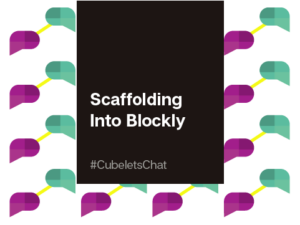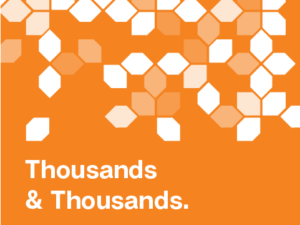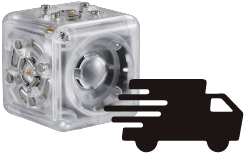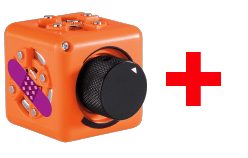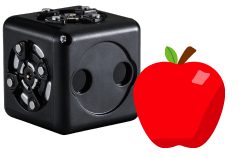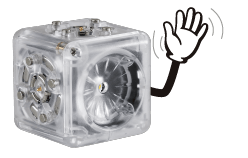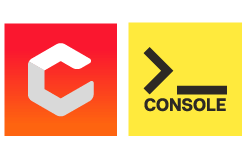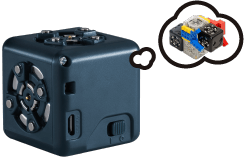Our Cubelets Lesson Plans all use a common format. This format is our version of an Inquiry Framework. We intentionally modified this framework from the Denver Museum of Nature and Science to represent how student mindsets change throughout the learning process.
At the beginning of a lesson or unit, students are filled with wonder and excitement. Ideally, they’re asking tons of questions and intuitively predicting the solutions based on their background experiences.
Then, students engage in the core learning experience. This is the investigation or engineering design challenge that will gently lead students to answers (and often many more questions!).
Finally, students try to explain their new learning in their own words. They reference background knowledge from prior to the lesson as well as new information they gathered during the investigation or design process. Students share their explanations with each other and use their classmates as sounding boards to tweak and refine their understanding. Sometimes they even go back to investigate or redesign again!
The very last step is less of a student mindset and more of an educator mindset. Taking the time to accurately gather formative data throughout a unit helps teachers more quickly identify students’ synthetic models and adjust student groups to better address common questions.
This Inquiry Framework is most valuable because it can easily be translated into inquiry investigations or into guided release of responsibility lessons. It can stretch to the length of an entire unit or squeeze everything into one individual lesson. Its flexibility is what makes it so useful. Every teacher, in every subject, can see themselves in our framework and also identify places to grow professionally.
Cultivate Wonder
This first section is the hook for the lesson. This is where we introduce the learning goals for the day and connect to students’ schema. Sometimes to Cultivate Wonder, we might share a short text to develop common vocabulary or surprise students with a phenomenon or discrepant event. Other times, we might simply pose an anchor question and give students time to brainstorm what they already know about it.
Regardless of how we structure this Cultivate Wonder time, our purpose is to stoke students’ natural curiosities to help them develop their own interests related to the day’s learning task.
Experience Before Expertise
During an inquiry-based lesson, this time is dedicated to student-driven investigation. This time should be loud, messy, and chaotic. As educators, our role is to keep an eye on each group and be ready with a series of questions to scaffold our students’ learning.
During a gradual release lesson, this time is dedicated to modeling the task for students and leading a whole-group shared practice session. It is a great time for students to be following along, trying the new strategy on their own, and turning to talk with their peers about their concerns and misunderstandings. Because this time is all about building Experience Before Expertise, all student work produced during this time should remain ungraded and only used as formative, real-time data for us to modify our instruction.
Co-Construct Meaning
This is when the training wheels come off and the rigor of the lesson shines.
During an inquiry-based lesson, this is a whole-group opportunity for groups to share their conclusions and inventions, and collect feedback from their peers. Co-Constructing Meaning conversations work best when they are anchored to the original learning question of the day and predominantly include student-to-student conversations as opposed to being a call-and-response with the teacher. This means we need to be ready with:
- 3-5 intentionally planned extension questions for the discussion,
- A protocol for students to follow as they learn this type of communication,
- The main points (with evidence) that we want all students to walk away with.
At the end of this conversation, always pause to summarize the class’ findings to clarify the day’s takeaways.
During a gradual release lesson, Co-Constructing Meaning is the time when students begin to practice in small groups and independently. While students still have access to any of the models or anchor charts from the Experience section of the lesson, this is the first time they are trying to replicate the strategy without us as their guide.
It is helpful to allow students to talk with each other during this Co-Constructing Meaning time, but also make sure every student is independently accountable for recording their own thinking. Not only does this help students better understand where they are stuck, but this is also the first opportunity we have to identify individual preconceptions that may have flown under the radar while we were Building Experience Before Expertise.
Check for Understanding
Often used as a formative assessment within a longer unit, this is the time for students to confirm what they do and don’t understand about the day’s learning target. Usually, this is done by completing an Exit Ticket, either written or verbal. During the Check for Understanding, we often discover students who understand more than they let on during Co-Constructing Meaning or, conversely, some who may be even more confused than we thought. This is normal and expected, and is yet another great reason to prepare our students for flexible grouping so we can easily group students with common misunderstandings at the beginning of the next class.
I love to ask students (and adults!) to rate their confidence during the Exit Ticket response so that I can group students the following day according to common confidence intervals, as well as common misconceptions or extension projects. This helps balance my groups more evenly and also provides the opportunity for students to regularly practice self-assessment.
As you may have noticed, this framework aligns closely with the 5E model (engage, explore, explain, extend, evaluate) but provides more flexibility within different lesson styles and objectives.
One of my favorite things about our Inquiry Framework is how it ebbs and flows throughout an entire unit. For the first few days, most of our class time is spent Cultivating Wonder and Experience Before Expertise. As we hit our stride in the middle of the unit, we concentrate mostly on building Experience Before Expertise and Co-Constructing Meaning, and at the end of the unit, we compile all of our Co-Constructing Meaning conversations with data from our Experience Before Expertise time to synthesize and summarize our final thoughts about the topic. This could be in the form of compiling a portfolio, writing a scientific paper, inventing a new robot, or any number of other things. The specific artifact matters less than the thinking it shows.
Just like Cubelets, our Inquiry Framework is made to flex between levels of abstraction: constantly zooming in and zooming out from one lesson to a whole arc of learning.
Enjoyed this blog post? Sign up for the #CubeletsChat newsletter to receive the next blog post straight to your inbox. Plus join the discussion on twitter using the #CubeletsChat hashtag!
